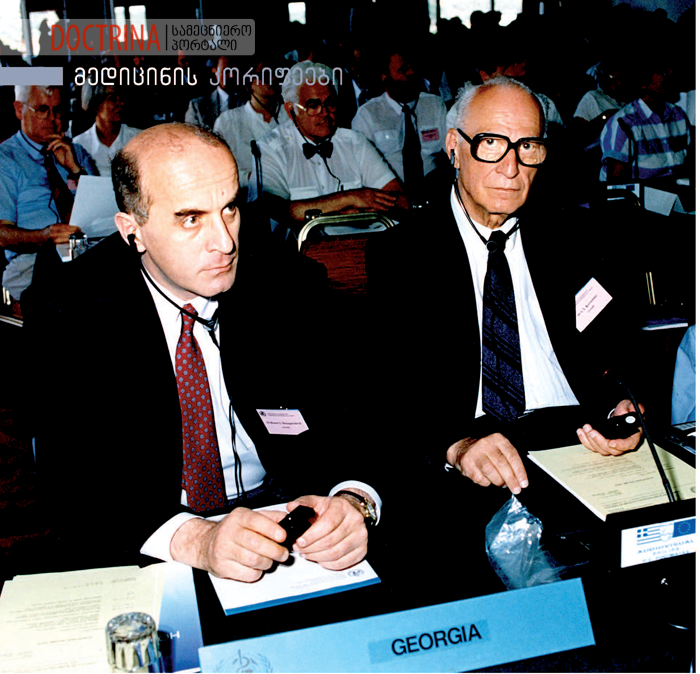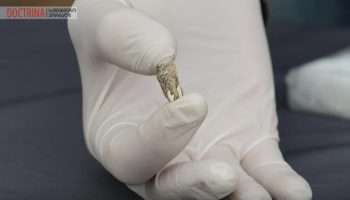Today, amid the global coronavirus pandemic, infectious disease specialists are the doctors, who stand at the frontline of the fight against the novel coronavirus.
Mr. Tamaz Kereselidze is one of the main figures who has contributed to the creation of this school.
“Tamaz Kereselidze, the man who defeated one of the most dangerous enemies of humanity- the smallpox infection, and who has been nominated for the Nobel Prize”
Mr. Tamaz Kereselidze was the gentle, curious, multi-talented child, who was fond of reading, music, painting and technical disciplines. Professor Astakhishvili has noticed his absolute ear and retentive memory and enrolled the talented teenager in his violin classes.
Why didn’t Tamaz Kereselidze become a violinist and how did he appear in medicine?
“At that time, boys, who was playing the violin, were often humiliated by their peers and since Tamaz was a proud boy, he unfortunately, stopped the music lessons, but the love of music followed him forever.
Tamaz also had remarkable drawing skills. In his childhood, Tamaz also wrote short stories and illustrated them himself. Later, when he grew up, he bought textbooks and mastered painting techniques independently. He loved painting during his whole life and, despite of his busy lifestyle, Tamaz always managed to paint. In his spare time, he created paintings that still decorate the walls of our and our children’s homes. These paintings are a precious relic left to us by Tamaz, and professional artists evaluate them as quite serious works, Nino Kereselidze, Tamaz Kereselidze’s wife (magazine Aversi N136)”
In 1943, Tamaz Kereselidze graduated with honors from Tbilisi Secondary School No. 18. He intended to continue his studies at the Institute of Shipbuilding, but due to the Second World War, these institutions, which were then only in Leningrad and Odessa, were moved to distant Siberia, and the parents did not allow their only child to continue his studies in Siberia. Tamaz chose to study medicine. In the same year he enrolled in the medical department of Tbilisi State Medical Institute, where he also graduated with honors in 1948. From the very beginning, his goal was to study microbiology and epidemiology.
In the same year he enrolled in the Medical Institute and Nino Todua joined the same group. They got married shortly after graduating from the institute. Everyone unanimously noted that Tamaz Kereselidze’s success was a great merit of his wife, who did everything to support his husband’s career. Although both of them put the family first, they have never stopped their professional activities.
After graduating from the institute, Tamaz Kereselidze started working at the Scientific Research Institute of Microbiology, Epidemiology and Bacteriophage. The young, talented and perspective researcher was soon promoted and in 1952 was appointed head of the department of the institute. Simultaneously, he was a graduate student of the Department of Microbiology of the Medical Institute. He went through the path of a rich creative work from the department’s assistant to the board.
In 1958, the young scientist completed his dissertation on the topic : “For the Issues of Antibody Products and Reproduction.” In 1960, he was elected an associate professor at the Department of Microbiology. Tamaz Kereselidze’s fruitful scientific and pedagogical activity began from this period.
In 1964, a new stage came in Tamaz Kereselidze’s life – he was invited to the World Health Organization as a consultant. The Georgian scientist has worked in the Regional Bureau of Southeast Asia in India, and from 1966 to 1970 he served as a senior specialist in the Department of Bacterial Diseases at the organization’s headquarters in Geneva, Switzerland.
While working for the South East Asia Regional Bureau, the Georgian microbiologist made an invaluable contribution to the program of the fight against dangerous diseases such as the plague, cholera, and smallpox in India, Nepal, Pakistan, Bangladesh, and Afghanistan.
Nino Kereselidze, Tamaz Kereselidze’s wife recalls:
He often had to go on business trips to dangerous places. I remember the joint event of the World Health Organization and the International Committee of the Red Cross aiming to help the affected population in the aftermath of the natural disasters in Pakistan and Bangladesh. Tamaz was also in the group of doctors sent for this purpose together with Academician Valentin Pokrovsky. The plane, with this team on board, appeared in an unfavorable meteorological environment and survived the disaster only thanks to the great efforts of the pilots. He has had some funny stories, too. After one of the trips, he was summoned from India to Moscow. It was very cold in Moscow, and he only wore clothes suitable for the Indian climate. The next day I arrived in Moscow and took warm clothes for him. The door to his room was opened by a bearded man. I thought I entered the wrong room, because I could not recognize Tamaz, who grew a long beard. We laughed a lot at this story and took a memorable photo. ”
In 1970, Tamaz Kereselidze returned to the Department of Microbiology of the Medical Institute in Georgia and, together with his active scientific and pedagogical work, he started to summarize the knowledge and experience gained while working in the World Health Organization. This knowledge and experience was reflected in his monographs and doctoral dissertations. The monograph “International Aspects of Fighting against Cholera” was published in 1971 in Moscow. In 1972, Mr. Tamaz defended his doctoral dissertation at the Gamaleya Institute of Epidemiology and Microbiology, Academy of Medical Sciences in Moscow. The topic of the dissertation was “Microbiology and Epidemiology of El-Tori Cholera”.
In 1974, Tamaz Kereselidze was elected the Head of the Department of Microbiology at the Tbilisi State Medical Institute, and in 1976, he was awarded the title of Professor.
We should underline the valuable contribution of Tamaz Kereselidze to the defeat of smallpox. In 1976, by the initiative of the WHO, a grand program to eradicate this dangerous disease was launched, which was attended by specialists from the world’s leading countries, including the United States, Great Britain, Germany, France and the USSR. Great work has been done, and in 1980 WHO officially announced the global eradication of smallpox. The entire working group was nominated for the Nobel Prize.
Tamaz Kereselidze received an extraordinary award of the Minister of Health of India for his contribution to the elimination of smallpox in India.
In 1980, the World Health Organization dedicated a special session to the successful completion of the global eradication of smallpox. Tamaz Kereselidze received a letter of thanks from then Director General of the organization, Dr. Halfdan Mahler, and awarded the Order of Bifurcation Needle for his contribution to the implementation of the program. Only a few scientists from all over the world have been awarded this order, and Mr. Tamaz is the first Georgian physician to receive this great award.
In 1974-1984, Tamaz Kereselidze was re-invited by the World Health Organization to head the Global Program for Bacterial Infections. At the same time, he was an expert at Infectious Diseases Society of the UK and the U.S. Center for the Study of Resistance to Antibiotics.
Nino Kereselidze, Tamaz Kereselidze’s wife recalls:
“In 1984, Tamaz finally returned to Georgia and continued to work as the Head of the Department of Microbiology, Virology and Immunology at the Medical Institute. He was actively involved in the pedagogical, scientific and public work. He gave lectures, supervised the education of young scientists, and conducted scientific conferences. His lectures were so interesting that the audience could not accommodate the students. Despite the lack of technical means, Tamaz managed to visualize the material for the students. He used the video and photo footages taken in Asia and Africa. Generations of his former students still remember these lectures and the respect they felt for Tamaz.”
For years, Tamaz Kereselidze had been the republic’s chief epidemiologist, chair of the Georgian Society of Microbiologists, Epidemiologists and Parasitologists, a member of the Union Commission for Microbiology, a member of the Scientific Qualifications Council of the Medical Institute, and a member of the editorial board of the journal Soviet Medicine. During this time he wrote several monographs, a textbook on epidemiology (with O. Kaviladze) and more than a hundred scientific papers.
Tamaz Kereselidze was elected a WHO expert in 1985, and in 1992 Georgia became a member of the World Health Organization. In the same year, Mr. Tamaz was appointed a coordinator of this organization in Georgia and until the end of his life he looked after to deepen the cooperation between the World Health Organization and the governmental and non-governmental organizations of Georgia. In 1995, he started managing the restoration of the Georgian Medical Information and Statistics Service, equip and link it to the World Health Organization. Already in 1996 it became possible to publish the first statistical reference, which reflected the statistical data of Georgia at the national and regional levels.
Professor Tamaz Kereselidze’s scientific-pedagogical and public activities have been awarded many prizes, the Medal of Honour in Health, Health Service Achievement Medal, the Certificate of Honor of the Presidium of the Council of Ministers of the USSR and others. His biography is included in the publication Who is Who in the United States ”(1986-1990). Under his leadership, many PhD and doctoral dissertations have been defended.
Tamaz Kereselidze was a distinguished person. A refined intellectual, a professional, an erudite, a philanthropist, a master of humor, a true patriot of his country.
He enjoyed great authority not only among his colleagues, co-workers and friends, but also in the in international scientific circles.
The Hall of Young Scientists & Analysts – “Doctrina”







